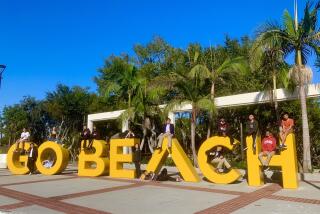CSUCI Site Authority OKs Development Plan
- Share via
Cal State officials signed off on a blueprint for development at Ventura County’s public university Monday, laying the groundwork for the creation of a range of income-generating ventures designed to help expand the campus over the next 25 years.
The CSU Channel Islands Site Authority approved a master plan to guide development of a self-contained community at the Camarillo campus--a proposed mini-city of 900 houses anchored by a town square and dotted with bicycle paths, parks and pools.
The plan also calls for creating a child-care center, a kindergarten-through-eighth grade school and a research-and-development center around the campus core.
The projects are designed to generate the millions of dollars needed to create academic space for as many as 15,000 students eventually expected to attend Cal State Channel Islands.
The master plan, along with an environmental study and a reuse plan for the property also approved Monday, goes to the CSU Board of Trustees in July for final approval.
“It’s an important day,” said Handel Evans, president of the university, which is under development at the former Camarillo State Hospital complex.
“Going back several years, when we started from zero, I think this effort has been a wonderful example of consistency,” he said. “Now this university is well on its way . . . to becoming a first-class facility in a first-class place with first-class programs.”
The Camarillo campus--which opened last fall as a branch of Cal State Northridge--is scheduled to evolve into a free-standing, independent, degree-granting institution by fall 2002.
But the CSU governing board has made it clear that the only way that will happen is if Channel Islands officials find a way to generate the cash to expand academic programs and facilities.
Toward that end, the Channel Islands Site Authority, a seven-member panel that serves as landlord and financial manager for the campus, has been crafting a master plan for development at the site.
At the heart of the development is a range of housing for students, faculty and staff members. The master plan calls for a mix of “for sale” and rental housing, plus dormitory-style housing for 2,000 students.
Other money-making ventures include creation of 350,000 square feet of research-and-development space that would be available for lease. Full build-out of the housing and research-and-development area is expected by 2008-09.
Initially, environmentalists and others expressed concern about the university projects, fearful that they would pull city-style sprawl toward the campus.
But those early critics have fallen silent, which was evident Monday when no one showed up to speak at a public hearing on the development proposals.
“I think you’ve done a really good job,” county Supervisor Frank Schillo, who is also a site authority member, told CSU staff members. “Usually, with something of countywide significance, there would be about 5 million people packed in here.’
The master plan was first unveiled in 1998, and Channel Islands officials have explored a variety of income-generating ventures since then. Among the first proposals, which have since been abandoned, was creation of a golf course, conference center and a retirement complex on the outskirts of the campus.
The plan was refined over the years--on the advice of consultants and through meetings with residents--to the document approved Monday.
One change that received plenty of discussion, however, was the need to purchase and plow under 75 acres of adjacent farmland. CSU planners said the land is needed for a new road that will serve as the primary access to the campus. The master plan also calls for creation of a wetland area and athletic fields on that acreage.
But Supervisor John K. Flynn, an early critic of the intense development that would take place around the campus, said the loss of the acreage in this case is for a greater good.
“They’ve got to have flexibility to do what they need to do to make it successful,” Flynn said. “I think they’ve done as good a job as possibly can be done, being sensitive to the county’s growth plans while at the same time building a university that will be viable and strong.”
More to Read
Sign up for Essential California
The most important California stories and recommendations in your inbox every morning.
You may occasionally receive promotional content from the Los Angeles Times.













